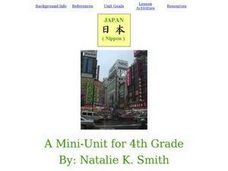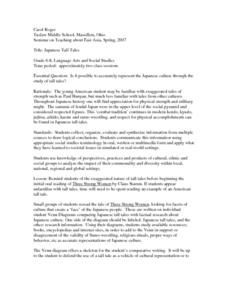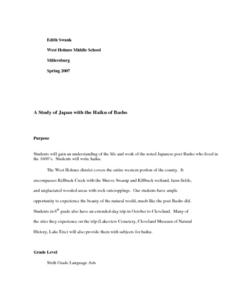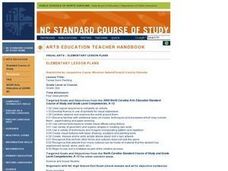Curated OER
Gifts of All Sizes
High schoolers explore the concept of philanthropy. In this stewardship lesson, students consider human capacity for generosity as they read folktales from different cultures that feature characters giving of themselves.
Curated OER
Japanese Inspired Activities for the Classroom
Students become more aware of cultural differences by reading a variety of multicultural books about social issues. They assess various Haiku's by Lee Bennett Hopkins, Kamishibai stories by Dianne Clouet and snapshots from Japan by Peter...
Curated OER
SONGS IN JAPANESE
Students become familiar with the sound of Japanese by singing familiar songs in Japanese.
Curated OER
Social Studies: Exploring Japan
Fourth graders examine the culture and environment of Japan, beginning with a KWL chart. They use clay and cups of water to construct representations of the Japanese Islands. After designing flags representing farming and food, 4th...
Curated OER
Ukiyo-e
Young scholars investigate and examine ukiyo-e, or Japanese woodblock prints, from the Edo period (1615-1868) in Japan and use this gained knowledge to compare Japanese culture to American societal trends.
Curated OER
PowerPoint Presentation
Learners work together to research different aspects about the country of Japan and its culture. Using PowerPoint, they organize their information to be shared with their classmates. They are asked questions by their teacher to end their...
Curated OER
Netsuke
Students identify different objects from Japanese culture and their purpose. They read Japanese folktales and discuss common themes. They create a sketch and clay sculpture of a character or animal in one of the folktales.
Curated OER
What to Wear: Career Day! Suit of Armor From Japan
Students understand that some jobs require workers to wear special clothes or a special suit. In this art appreciation instructional activity, students observe the Suit of Armor and discuss how a samurai is requires to wear armor to...
Curated OER
Making A Karuta Game
Students explore the culture of Japan be creating a traditional Japanese game called Karuta. They conduct research in order to find the rules for the game and to make cultural connections. The content of the game is modified according to...
Curated OER
Rice is Nice
First graders explore Japanese foods through fairy tales, fiction and nonfiction books, cooking meals and eating with chopsticks. After all of the creative ideas have been utilized, the class holds a tea party for parents in the classroom.
Curated OER
Japanese Tall Tales
Students read the tale of 'Three Strong Women' looking for facets of culture that create a 'face' of the Japanese people. They create a Venn Diagram comparing Japanese tall tales with factual research about Japanese culture. One side...
Curated OER
Moral and Ethical Beliefs: Proverbs
Students compare and contrast the cultures of Japan and the United States. In groups, they are given a proverb from each country and note the similiarties in their teachings. They complete a worksheet and share their findings with the...
Curated OER
Japanese Bookbinding Kit
Students are introduced to Japanese bookbinding techniques. In groups, they compare and contrast the western style against the Japanese style. As a class, they make their own book binding to present the material in a more interesting way.
Curated OER
Teaching the Hindu-Buddhist Tradition in East Asian Culture Through Asian Literature and Film
Students explore various intellectual traditions which dominate human history through a variety of contemporary pieces of literature which exemplify the traditions. Biblical monotheism, Greek rationalism, Hinduism, Buddhism, Confucianism...
Curated OER
Rethinking Time, Age, And the Calendar
Students creat personal timelines, marking key events in their lives. They discuss the different events with a small group. They analyze how Western Civilization influenced their timeline in comparison to Eastern Asia.
Curated OER
Family Life Around the Globe
First graders examine customs of other nations and compare countries using Venn diagrams. They also write pen pal letters and e-mails to students in other countries.
Center for History Education
Japanese American Internment During World War II
World War II turned nations against each other and neighbors into enemies. An eye-opening lesson explores the dark past of Japanese-American internment camps during WWII. Scholars learn of the fear and distrust toward Asian Americans...
Curated OER
Religion in Japan Elderly in Japanese Society
Students study changes in age demographics of Japanese society and the impact that these changes are having on the economy, health care, family structure and workforce. They identify and predict what future changes occur as a...
Curated OER
Music in Japan - Fine Arts
Second graders discuss various types of music. They identify and explore Japanese music, and instruments. They make a koto.
Curated OER
A Study of Japan with the Haiku of Basho
Sixth graders explore haiku poetry and the works of the Japanese poet Basho. They review characteristics of haiku poetry and other forms of poetry. After they write three or more haiku poems, they illustrate one of them and share with...
Curated OER
Kites of Japan
Students perform research into the designs of Japanese kites in order to appreciate them for their aerodynamic designs. The appreciation builds student interest in order to produce their own similar designs.
Curated OER
The Concept of Wa III
Twelfth graders continue to compare the ways Japan and the United States resolve disputes. In groups, they are given a case in which they apply the concepts of wa to resolve the issues. They predict how the judge in the case dealt with...
Curated OER
Tansai Sumi Painting
First graders study Japanese art and apply the technique of Tansai Sumi (lightly colored) to create individual works of art. Painting, design, lines, and drawing techniques are covered in this 1st grade lesson.
Curated OER
New Year Celebrations in China (Chun Jie)
Fifth graders compare and contrast the traditions and customs of the holiday with those in Korea and Japan. They express themselves with few non-native grammatical errors in speaking and writing; develop and use background...























